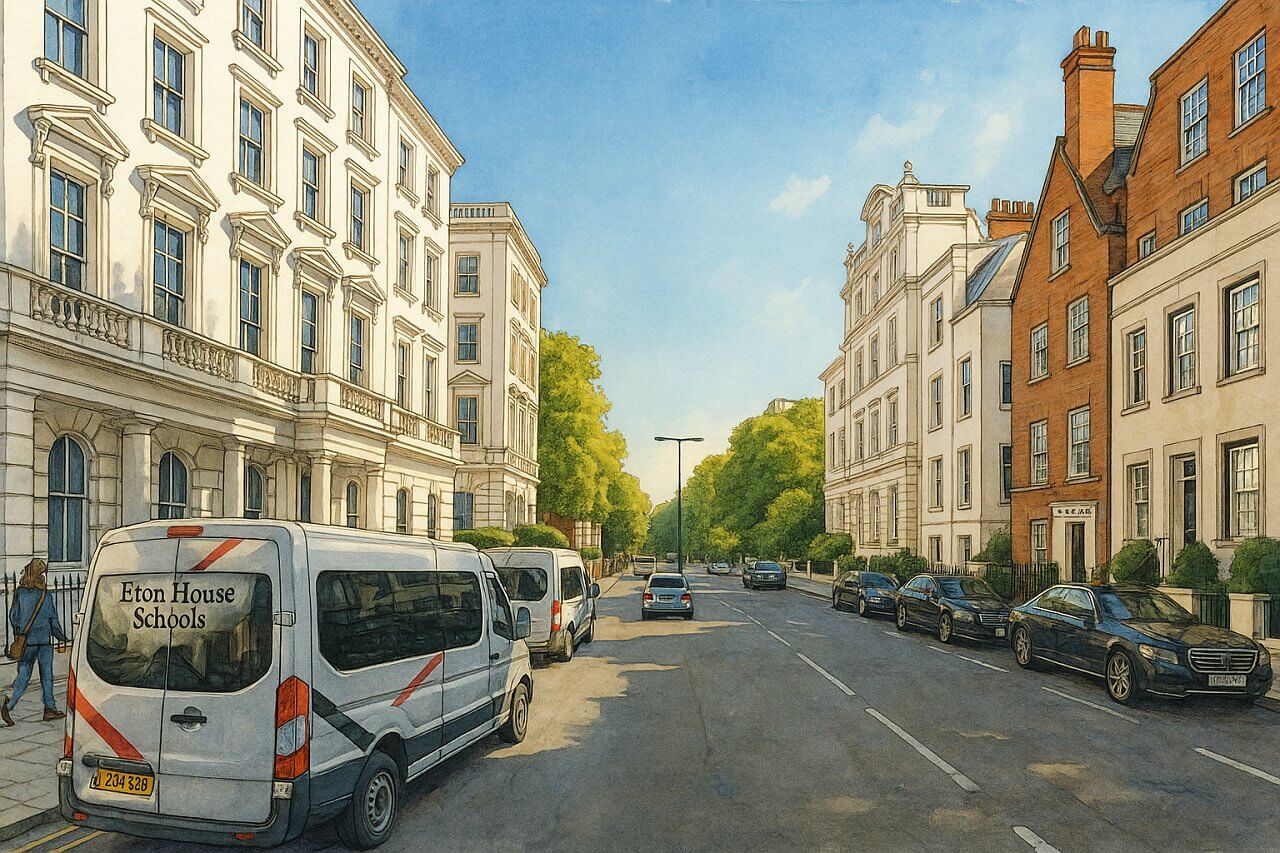
Eaton Gate, London
Eaton Gate is a short but elegant street in the heart of Belgravia, one of London’s most prestigious neighbourhoods. It forms a distinguished connection between the south-west corner of Eaton Square and Cliveden Place, at the junction with Eaton Terrace. Despite its modest length, Eaton Gate is steeped in heritage, lined with striking architecture, and known for some of the capital’s most exclusive residential real estate.
Overview and Traffic
Eaton Gate is approximately 160 metres (525 feet) long, running in a southwest to northeast direction. Vehicular traffic flows one-way from Cliveden Place towards Eaton Square. The road accommodates two lanes of traffic and is flanked by wide pavements and mature plane trees, contributing to its stately appearance.
History and Name Origin
Eaton Gate was developed as part of the grand vision for Belgravia by the Grosvenor family during the early 19th century. Most of Belgravia was built in the 1820s and 1830s following the success of neighbouring Mayfair. The land had been acquired by Sir Thomas Grosvenor through marriage in the late 1600s and eventually became the Grosvenor Estate.
The name “Eaton” is derived from the Grosvenor family’s ancestral estate in Eaton Hall, Cheshire. The street was likely named in the 1820s or 1830s, in keeping with the naming conventions across Belgravia. The name is pronounced EE-t'n, and the International Phonetic Alphabet (IPA) transcription is /ˈiːtən/. 
Architectural Character
Eaton Gate is marked by a restrained grandeur, lined with tall, white-stuccoed houses typical of Belgravia’s early Victorian era. Many buildings feature neoclassical facades with pillars, porticoes, and decorative ironwork. These houses were originally built as large single-family homes, although many have since been converted into luxury flats or embassies.
The street also hosts some elegant post-war buildings that seamlessly blend with the original architectural tone of the area. The general atmosphere is quiet, exclusive, and highly residential, with well-maintained gardens and minimal commercial activity.
Nearby Sights and Attractions
While Eaton Gate itself is primarily residential, it sits just moments from a number of noteworthy attractions:
- Eaton Square – One of London's grandest residential squares, known for its landscaped gardens and historical buildings.
- Sloane Square – Just a few minutes’ walk away, this fashionable plaza offers boutiques, cafés, and access to the Royal Court Theatre.
- Saatchi Gallery – Located at Duke of York Square near Sloane Square, featuring contemporary art exhibitions.
- Pimlico Road Design District – Nearby area renowned for luxury interiors, antiques, and art galleries.
Property and Real Estate
Eaton Gate is home to some of the most expensive residential properties in London. As of early 2025, flats and houses here command prices ranging from £2 million to £15 million, depending on size and specification.
Typical two-bedroom flats here range between 1,000–1,500 sq ft (93–140 sq m), while entire townhouses can exceed 5,000 sq ft (465 sq m). These values far exceed average London prices, reflecting the area’s desirability, architecture, and prestige.
Transport Links
Underground Stations
The nearest London Underground station is Sloane Square, located around 5 minutes’ walk to the south. It is served by the:
Also within walking distance is Victoria Station (approximately 10 minutes away), served by the:
- Victoria Line
- District Line
- Circle Line
Bus Stops
The nearest bus stops are located on Lower Belgrave Street, Ebury Street, and around Sloane Square. Routes serving these stops include:
- Bus 11 – From Fulham to Liverpool Street
- Bus 137 – From Streatham Hill to Marble Arch
- Bus 211 – From Hammersmith to Waterloo
- Bus 360 – From Elephant & Castle to the Royal Albert Hall
Fun Fact
Despite being only about 160 metres long, Eaton Gate has served as a discreet address for several ambassadors’ residences and prominent business figures. Its secluded but central location, grand houses, and proximity to both Victoria and Chelsea have made it an ideal spot for those seeking prestige and privacy.
Quick Facts
- Location: Belgravia, City of Westminster, London
- Connects: Eaton Square (NE) to Cliveden Place and Eaton Terrace (S)
- Length: Approximately 160 metres (525 feet)
- Traffic Direction: One-way from south to north
- Named After: Eaton Hall in Cheshire, ancestral seat of the Grosvenor family
- Pronunciation: EE-t'n /ˈiːtən/
- Nearest Underground: Sloane Square (District & Circle Lines), Victoria (Victoria, Circle & District Lines)
- Nearby Bus Routes: 11, 137, 211, 360
- Notable Nearby Attractions: Eaton Square, Sloane Square, Saatchi Gallery
- Property Prices (2025): £2M–£15M; flats 1,000–1,500 sq ft (93–140 sq m), houses 5,000+ sq ft (465+ sq m)
- Architectural Style: Early Victorian, neoclassical stucco-fronted houses
- Fun Fact: Has housed ambassadors and influential business figures
Who Were the Grosvenors, and How Did They Acquire This Land?
If you're wondering why so many streets and squares in this area bear names like Grosvenor, Belgrave, Eaton, or Wilton, it's because much of this land once belonged to the powerful Grosvenor family. To find out how they came to own vast swathes of Mayfair, Belgravia, and Pimlico — and whether they had any ties to the government or the royal family — read our in-depth article here.
Map of Eaton Gate, London

Painting of Eaton Gate, London (View image in full size)